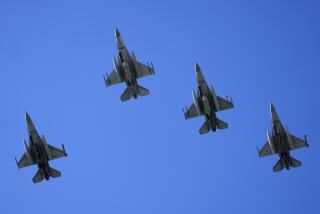Military Coming Up Short on Modernization Efforts : Pentagon: Focus on readiness is shifting money from arms development. Flow of equipment is but a trickle.
NEW RIVER, N.C. — Eyes peeled for errant ground traffic, Capt. Scott Whitaker eases his aging, faded-gray CH-46 Sea Knight toward the stubby runway at the Marine Corps helicopter base here and prepares for a quick takeoff.
His mission today is simple: pick up a squad of Marines from a field and then hover over a cinder-block building so they can slide down a rope to the rooftop and launch a mock attack against the “enemy.” He has flown such training missions dozens of times.
But this morning his CH-46 is not going anywhere. A glance at the freshly stained Tarmac shows that the aft rotor head is spewing oil, the result of a lube-line connection that has worked itself loose. Seconds later, both engines are shut down.
The 30-year-old CH-46, the oldest helicopter in the armed forces, has become a symbol in one of the hottest debates in Washington: whether the United States is keeping pace in modernizing its military.
A look around any military installation will show that the problem has not taken on crisis proportions. America’s armed forces still are the world’s best equipped, bristling with expensive, high-tech weaponry. Serious shortages are almost unknown.
But recent deployments of troops to Somalia, Haiti and other trouble spots have crimped money for modernization as the Pentagon, concerned about maintaining overall readiness, has sought to finance these operations by shifting money away from weapons development and procurement.
That strategy seemed sensible enough during the early 1990s. The military was still reaping the fruits of the Ronald Reagan Administration’s defense buildup, and planes, tanks, ships and other equipment--ordered when the Pentagon budget was flush--were still coming through the pipeline.
Purchases Put Off
But today the flow has trickled almost to a halt, and the procurement budget has shrunk markedly. Purchases of many new weapons have been postponed, and the Pentagon is not buying enough to replace existing equipment before it wears out.
Modernization “is virtually at a standstill,” said Robert W. Gaskin, a former Pentagon strategist with Business Executives for National Security, a defense-monitoring group. “What’s going to happen in the long run is that you’re going to wind up with fighter aircraft that are 40 years old and you won’t be able to keep them up. We’re eating our seed corn. It’s a big worry.”
Most troubling to members of the Joint Chiefs of Staff is the outlook for the period between now and the 1998 fiscal year, when the modernization budget is scheduled to begin increasing modestly again.
Next year, for example, the Navy will build only three new warships to replace those that are completing their normal life span. The Army is not ordering any new tanks. And the four services combined are buying only 20 replacement jet fighters. In 1980 they bought 458.
At the same time, Pentagon budget-makers have postponed or capped production of a spate of new higher-tech weapons that the services have ordered--from the Army’s Comanche helicopter to the Air Force’s F-22 jet fighter to the Navy’s new attack sub.
The squeeze has military officers worried. “We cannot afford to maintain today’s readiness at the expense of modernization,” Gen. Ronald R. Fogleman, the Air Force chief of staff, warned recently in testimony before Congress. “To do so mortgages tomorrow’s readiness.”
Defense hawks in Congress have begun criticizing the Clinton Administration’s policy. Rep. Floyd Spence (R-S.C.), chairman of the House National Security Committee, has lambasted the plan as “shortsighted,” saying it “puts at risk our future military capability.”
Moreover, some analysts are worried that the modernization budget will be a tempting target even after the current squeeze is over. “They keep kicking this can down the road, but the road seems to be endless,” said Dov Zakheim of System Planning Corp., a consulting firm.
Obsolete Gear
The CH-46 is an oft-cited example. The aging medium-weight helicopter, still a Navy and Marine Corps staple, is not being manufactured anymore. Much of its equipment is obsolete, and many of the chopper’s key spare parts no longer are made.
The one that broke down on the Tarmac here was built in 1965, the same year Whitaker was born. Humor in the Marine Corps holds that “the last CH-46 pilot hasn’t been born yet,” Capt. Joachim Fack, Whitaker’s co-pilot, points out.
Moreover, the Sea Knight’s replacement, the tilt-rotor V-22 Osprey, will not begin to reach the fleet until sometime around the year 2001, leaving the Marines and the Navy having to make do well past the aircraft’s prescribed life span.
“What you’ve got there is literally a flying antique,” Gaskin said. “Even if they started producing the V-22 today, they’d still be using CH-46s for years.”
First Lt. Ken Wilson, the aircraft maintenance control officer at the New River base, chronicles the chopper’s problems while the lube-line connection is being repaired:
* The aging airframe is prone to corrosion and metal fatigue, necessitating frequent buttressing with “doubler” brackets, which can take hours to install.
* The rotor-head components, heater innards and dozens of other spare parts are not available anymore, forcing maintenance crews to cannibalize other aircraft or fabricate the parts themselves. The radios have vacuum tubes--virtually an electronic relic.
* Many of the model’s features are obsolescent. The heavy steel armor protecting the engine locker could be replaced by Kevlar, lightening the chopper’s weight by several hundred pounds. Another 100 pounds of hydraulics are unneeded: The equipment it served has been updated.
Not surprisingly, the shortcomings have crimped the performance of the CH-46: It now can only carry a fraction of the load it is supposed to. Its speed and range have been reduced. It no longer can bank at more than a 45-degree angle. And maintenance time has risen sharply.
The CH-46 is not the only old-timer that needs replacement. The Army, in particular, is anxious to modernize its tanks and Bradley fighting vehicles and to replace its aging trucks and howitzers, each of which already has far exceeded its useful life.
The Navy is behind in replacing many of its surface ships and attack submarines, its fighter aircraft and its anti-submarine-warfare planes. The Air Force has problems with aging fighters, cargo transport planes, bombers and training aircraft.
After adjustment for inflation, the services are spending less on weapons-modernization today than they have at any time since World War II.
Hoping for Savings
The Administration’s strategy in coping with the funding problem has been to squeeze the modernization budget in the short run, relying on hoped-for savings in future military budgets to provide for more weapons spending later.
For example, they say, budget-makers soon should begin to realize savings from the last few years’ cutbacks in the overall size of the military. Shortly after that will come the fiscal benefits from closing unneeded bases and reforming the Pentagon’s weapons-acquisition system.
And finally, in the year 2001 or so, the procurement budget itself is scheduled to increase again.
But outside analysts are skeptical that such hopes will be borne out. Partly because of high environmental-cleanup costs, the projected windfall from base-closings already has proved elusive, and the push toward acquisition reform is going more slowly than expected.
Indeed, Paul G. Kaminski, the undersecretary of defense for acquisition, conceded last week that the Administration’s assumptions may prove too optimistic--particularly if Congress fails to boost defense spending in later years and does not reimburse the Pentagon fully for such operations as Haiti and Somalia. This year, the lawmakers made the department cut other defense programs to finance those deployments.
Andrew F. Krepinevich, director of the Defense Budget Project, a defense-monitoring group, says the Administration would have been better off cutting a few big projects entirely rather than deferring production on so large a number.
“They are operating very close to the edge,” he said.
Don M. Snider, analyst for the Center for Strategic and International Studies, agrees. Instead of making piecemeal cuts, he says, Clinton should “skip a generation” of Cold-War-style weapons, such as the B-2 bomber, and concentrate on others, such as cruise missiles and hyper-velocity guns, that are needed to cope with future conflagrations.
Republicans have embraced a recommendation by a panel of retired admirals and generals that Congress keep Pentagon spending steady for at least several years to give service chiefs a chance to manage the trade-off between spending on readiness and on modernization.
There are signs that the Pentagon itself is worried as well. Defense Secretary William J. Perry recently proposed adding more than $1 billion a year to the Army’s $6.3-billion modernization budget to pay for needed upgrading.
“If you’re looking at an area where this budget can be criticized, I think that this is the area where it is most vulnerable,” the defense chief conceded in congressional testimony recently. But Perry’s proposed increase would be paid for by cutting another 20,000 troops from the Army’s active-duty roster and shifting money from other Defense Department projects--options not welcomed in those areas.
Moreover, analysts are uncertain that the White House will make good on its pledge to boost defense spending after fiscal 1997. They fear there will be another major re-evaluation of U.S. military strategy, leading to even further cuts in forces.
Snider, for one, says the fundamental problem is that the Administration is maintaining too large a force for the limited use it has in mind for military power. It must either cut the size of the military more or increase defense spending sharply to pay for it.
For now, military experts are complaining that the Administration is playing penny-wise and pound-foolish in allowing modernization efforts to slip.
Lask week, the House National Security Committee approved a Republican-crafted defense bill that would add $6 billion to the services’ combined $39.4-billion budget for weapon-modernization, but it is unclear whether the Senate will go along with that figure.
At New River, Whitaker and Fack are trying to make the best of the situation. To a certain degree, they are succeeding. “The ’46 is the last aircraft that really is designed for seat-of-the-pants flying,” Fack said, singling out one benefit of the old chopper. “It’s fun to fly.”
More to Read
Sign up for Essential California
The most important California stories and recommendations in your inbox every morning.
You may occasionally receive promotional content from the Los Angeles Times.










